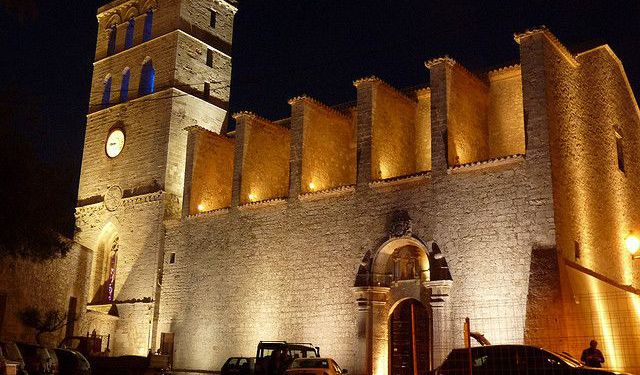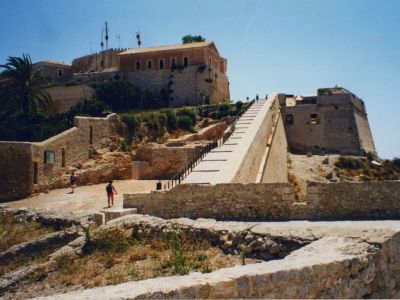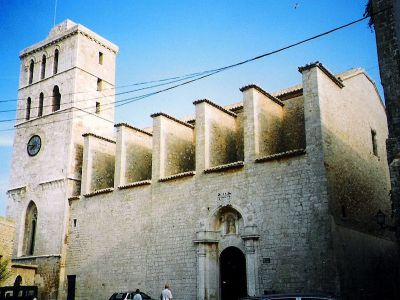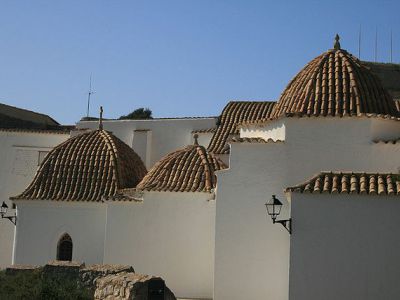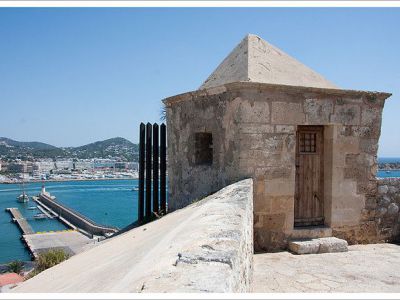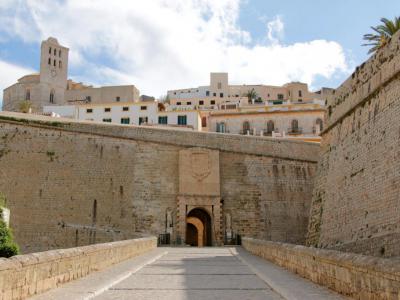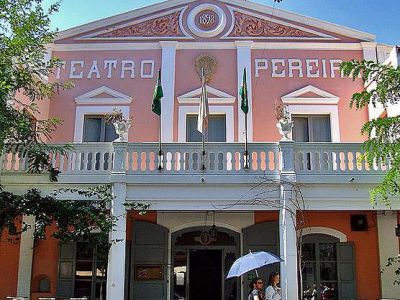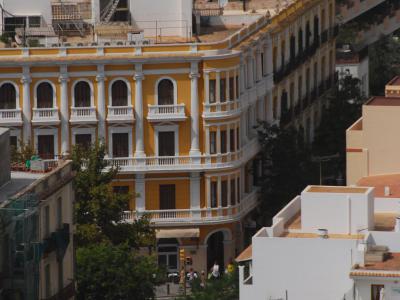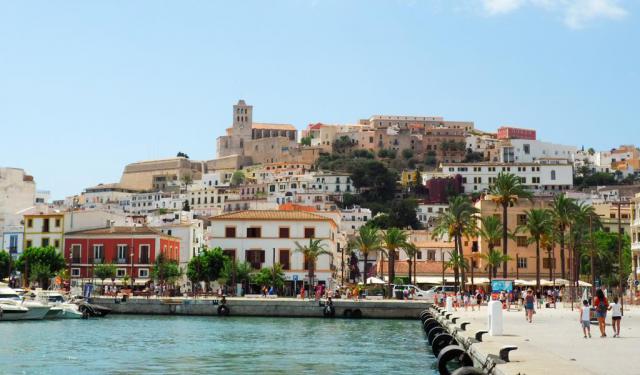Ibiza's Historical Buildings Tour (Self Guided), Ibiza
Thinking of Ibizan buildings, one may struggle a bit to imagine anything but the whitewashed villas peppering the landscape. However, a closer encounter reveals some less obvious examples of local architecture, each with their own place in the colorful and ever-evolving history of the city and the island.
The unique and long-stretching past of Ibiza produced an incredible architectural variety. With so many various cultural influences exerted over a great number of centuries, there is an eclectic blend of historic sites to behold. Here are some of the most iconic architectural landmarks in Ibiza:
Castle of Ibiza – the heart of the island, established in the 12th century;
Saint Mary of Ibiza Cathedral – a major local landmark since the 13th century;
St Vincent and St James Church and Convent – an excellent 16th-century blend of Moorish and Christian influences;
Baluard de Santa Llúcia (Santa Llúcia Bastion) – the largest bastion of the walled old city; designed in 1575;
Portal de ses Taules (Ses Taules Gateway) – built in 1585; the main entrance to the fortified old town;
Teatro Pereyra (Pereyra Theatre) – the Neo-classical structure, renowned for its pink-and-white façade; the city's first theater, built in 1898;
Gran Hotel Montesol Ibiza – a true symbol of the past with its colonial style; built in 1932.
To discover these and other historical buildings of Ibiza, take this self-guided walking tour.
The unique and long-stretching past of Ibiza produced an incredible architectural variety. With so many various cultural influences exerted over a great number of centuries, there is an eclectic blend of historic sites to behold. Here are some of the most iconic architectural landmarks in Ibiza:
Castle of Ibiza – the heart of the island, established in the 12th century;
Saint Mary of Ibiza Cathedral – a major local landmark since the 13th century;
St Vincent and St James Church and Convent – an excellent 16th-century blend of Moorish and Christian influences;
Baluard de Santa Llúcia (Santa Llúcia Bastion) – the largest bastion of the walled old city; designed in 1575;
Portal de ses Taules (Ses Taules Gateway) – built in 1585; the main entrance to the fortified old town;
Teatro Pereyra (Pereyra Theatre) – the Neo-classical structure, renowned for its pink-and-white façade; the city's first theater, built in 1898;
Gran Hotel Montesol Ibiza – a true symbol of the past with its colonial style; built in 1932.
To discover these and other historical buildings of Ibiza, take this self-guided walking tour.
How it works: Download the app "GPSmyCity: Walks in 1K+ Cities" from Apple App Store or Google Play Store to your mobile phone or tablet. The app turns your mobile device into a personal tour guide and its built-in GPS navigation functions guide you from one tour stop to next. The app works offline, so no data plan is needed when traveling abroad.
Ibiza's Historical Buildings Tour Map
Guide Name: Ibiza's Historical Buildings Tour
Guide Location: Spain » Ibiza (See other walking tours in Ibiza)
Guide Type: Self-guided Walking Tour (Sightseeing)
# of Attractions: 7
Tour Duration: 1 Hour(s)
Travel Distance: 1.3 Km or 0.8 Miles
Author: rose
Sight(s) Featured in This Guide:
Guide Location: Spain » Ibiza (See other walking tours in Ibiza)
Guide Type: Self-guided Walking Tour (Sightseeing)
# of Attractions: 7
Tour Duration: 1 Hour(s)
Travel Distance: 1.3 Km or 0.8 Miles
Author: rose
Sight(s) Featured in This Guide:
- Castle of Ibiza
- Saint Mary of Ibiza Cathedral
- St. Vincent and St. James Church and Convent
- Baluard de Santa Llúcia (Santa Llúcia Bastion)
- Portal de ses Taules (Ses Taules Gateway)
- Teatro Pereyra (Pereyra Theatre)
- Gran Hotel Montesol Ibiza
1) Castle of Ibiza (must see)
The Castle of Ibiza, or Castell d'Eivissa in Catalan, can be argued to be the heart of the island. The castle grounds are located at the top of the fortified Upper Town. The castle is comprised of numerous buildings that include the Tower of Homage, the 8th century Almudaina, the governor's home and the 18th century infantry barracks.
The original foundations of the castle were created in the 12th century, though additions and restorations were continued for hundreds of years. Unfortunately, the castle fell into extreme disrepair and is now in a partially derelict state. Recent restorations have allowed portions of the castle to be open to the public.
Reconstruction efforts have been primarily focused on the Sant Jaume Bastion and the Sant Pere Bastion. Each of these bastions offer exhibitions that are open to the public. While visitors cannot enter the main castle, it is worthwhile to tour both of these bastions and the castle grounds.
The Sant Jaume Bastion is now a military museum. It houses a weapons exhibition with a focus on military technology from the 16th and 18th centuries. Visitors are welcome to touch the items on display, which include cannons, mortar, muskets, helmets and swords.
The Sant Pere Bastion shows the history of the castle. Tourists can see how the city wall was built through an audio visual display. The exhibition includes a reproduction of Renaissance-era scaffolding. Both bastions were designed by Giovanni Battista Calvi in 1555.
The buildings are open from Tuesday through Sunday throughout the year. During the winter months, from October to March, the hours are 10 AM to 4:30 PM on weekdays and 10 AM to 2 PM on weekends. From April to September, hours are 10 AM to 2 PM Tuesday through Sunday. The buildings are closed on bank holidays and from December 10 to February 28.
The original foundations of the castle were created in the 12th century, though additions and restorations were continued for hundreds of years. Unfortunately, the castle fell into extreme disrepair and is now in a partially derelict state. Recent restorations have allowed portions of the castle to be open to the public.
Reconstruction efforts have been primarily focused on the Sant Jaume Bastion and the Sant Pere Bastion. Each of these bastions offer exhibitions that are open to the public. While visitors cannot enter the main castle, it is worthwhile to tour both of these bastions and the castle grounds.
The Sant Jaume Bastion is now a military museum. It houses a weapons exhibition with a focus on military technology from the 16th and 18th centuries. Visitors are welcome to touch the items on display, which include cannons, mortar, muskets, helmets and swords.
The Sant Pere Bastion shows the history of the castle. Tourists can see how the city wall was built through an audio visual display. The exhibition includes a reproduction of Renaissance-era scaffolding. Both bastions were designed by Giovanni Battista Calvi in 1555.
The buildings are open from Tuesday through Sunday throughout the year. During the winter months, from October to March, the hours are 10 AM to 4:30 PM on weekdays and 10 AM to 2 PM on weekends. From April to September, hours are 10 AM to 2 PM Tuesday through Sunday. The buildings are closed on bank holidays and from December 10 to February 28.
2) Saint Mary of Ibiza Cathedral (must see)
The Saint Mary of Ibiza Cathedral is a major landmark on the island. It has stood at the top the old town of Ibiza since the 13th century. Once you step inside the walls of the Ibiza's historical quarter, your eyes are instantly drawn to the imposing fortified walls of the church.
Following the Catalan Conquest in 1235 when the Christian conquesters ousted the Moorish from “Yebisah”, a grand cathedral was commissioned for the town. It is said that the church was built upon the site of a former Moorish mosque, which was a common practice in colonial Spain to impose the Christian faith to the local population.
The Gothic style tower and chapel are part of the original construction and the interior of the church was redone in the Baroque style in the 18th century. The ancient Monstrance made of silver and gold and dating from 1399 is the cathedral’s most treasured artifact.
The eye-catching Madonna, known as Our Lady of the Snows, is another key feature of the cathedral. Inside the cathedral there is a Diocesan Museum where you can learn more about the church’s historical influence in Ibiza. Admission is free.
Following the Catalan Conquest in 1235 when the Christian conquesters ousted the Moorish from “Yebisah”, a grand cathedral was commissioned for the town. It is said that the church was built upon the site of a former Moorish mosque, which was a common practice in colonial Spain to impose the Christian faith to the local population.
The Gothic style tower and chapel are part of the original construction and the interior of the church was redone in the Baroque style in the 18th century. The ancient Monstrance made of silver and gold and dating from 1399 is the cathedral’s most treasured artifact.
The eye-catching Madonna, known as Our Lady of the Snows, is another key feature of the cathedral. Inside the cathedral there is a Diocesan Museum where you can learn more about the church’s historical influence in Ibiza. Admission is free.
3) St. Vincent and St. James Church and Convent
The Saint Vincent and Saint James Church and Convent is nestled in the Old Town of Ibiza. Established in 1592 as a convent church, it was not granted public church status to the San Pedro Apostol Parish until 1929. Inside the church there are several chapels that can be visited and which provide a glimpse of the “old Ibiza”.
The architecture of the church is an excellent example of the blending of Moorish and Christian influences on the island. Inside the church there is rich iconic artwork and many statues and grottoes featuring sumptuous gold leaf.
Several chapels feature impressive frescoes adorned with religious artworks. They include chapels of Madre de Dios del Rosario, Immaculate Conception and San Antonio. Each of these chapels has a distinctive style featuring architecture from the 16th to the 18th centuries.
The church is dedicated to Holy Christ of the Cemetery, and the site of the previous convent cemetery is where the Town Hall now stands. The church can be visited every day, except on Mondays.
The architecture of the church is an excellent example of the blending of Moorish and Christian influences on the island. Inside the church there is rich iconic artwork and many statues and grottoes featuring sumptuous gold leaf.
Several chapels feature impressive frescoes adorned with religious artworks. They include chapels of Madre de Dios del Rosario, Immaculate Conception and San Antonio. Each of these chapels has a distinctive style featuring architecture from the 16th to the 18th centuries.
The church is dedicated to Holy Christ of the Cemetery, and the site of the previous convent cemetery is where the Town Hall now stands. The church can be visited every day, except on Mondays.
4) Baluard de Santa Llúcia (Santa Llúcia Bastion)
Whenever you visit the Dalt Vila, make sure to go up to the Baluard de Santa Lucía. This is the largest bastion in the fortified Old Town of Ibiza – designed in 1575 by the Swiss military engineer Giovan Giacomo Paleari Fratino (1520–1586), known as El Fratin or Il Fratino ("The Little Friar"), who served the Spanish Emperor Charles V and his son Philip II.
The structure has a rather unusual, asymmetrical plan, with original canons still seen at the top, that once guarded the upper town. Part of the bastion is the so-called Polvorin, a building that used to serve as a powder and weapons depot – currently an exhibition hall. The bastion is also frequently used as a venue for concerts or other events, including parties for the International Music Summit.
Other than that, Santa Lucía offers fantastic views over the harbor and the Gulf of Ibiza, as well as onto the roofs of the old houses of the Sa Penya district, formerly a fishing quarter and now one of the town’s most picturesque neighborhoods.
The structure has a rather unusual, asymmetrical plan, with original canons still seen at the top, that once guarded the upper town. Part of the bastion is the so-called Polvorin, a building that used to serve as a powder and weapons depot – currently an exhibition hall. The bastion is also frequently used as a venue for concerts or other events, including parties for the International Music Summit.
Other than that, Santa Lucía offers fantastic views over the harbor and the Gulf of Ibiza, as well as onto the roofs of the old houses of the Sa Penya district, formerly a fishing quarter and now one of the town’s most picturesque neighborhoods.
5) Portal de ses Taules (Ses Taules Gateway)
The Portal de ses Taules, built in 1585, is the main entrance to the fortified old town of Ibiza and is situated between the bastions of Sant Joan and Santa Llúcia. The entrance gate forms part of the declared UNESCO World Heritage Site of the Dalt Vila old city. The entrance is flanked on either side by headless Roman statues and above the gate is the coat of arms of Phillip II on whose orders the city walls were built.
The statues that adorn the entrance were unearthed during construction of the gates in the 16th century. These days the statues are replicas, but you can see the originals in the Ibiza Archaeological Museum in the Ibiza Old Town. A plaque beneath the Phillip II coat of arms describes his dominions and the components of his royal shield.
When you pass through the gate you will see that the walls are two meters thick. Ibiza was under constant attack by invaders and marauders and needed strong defensive support. Originally there was a moat and a drawbridge that protected the city within its walls from siege. The drawbridge was replaced with a permanent bridge at the beginning of the 20th century.
The statues that adorn the entrance were unearthed during construction of the gates in the 16th century. These days the statues are replicas, but you can see the originals in the Ibiza Archaeological Museum in the Ibiza Old Town. A plaque beneath the Phillip II coat of arms describes his dominions and the components of his royal shield.
When you pass through the gate you will see that the walls are two meters thick. Ibiza was under constant attack by invaders and marauders and needed strong defensive support. Originally there was a moat and a drawbridge that protected the city within its walls from siege. The drawbridge was replaced with a permanent bridge at the beginning of the 20th century.
6) Teatro Pereyra (Pereyra Theatre)
For over 125 years, the Pereyra Theatre (Teatro Pereyra) has stood as a cornerstone of Ibiza’s social and cultural life. From its inception, the venue has been home to a diverse range of activities, including theatre performances, ballroom dances, variety shows, meetings, and film screenings, making it a key gathering spot for locals and visitors alike. Its significance to the island was officially recognized in 2006 when it was declared a Class 1 Cultural Heritage Site.
After undergoing 16 years of meticulous renovation, the theatre reopened its doors to the public, revitalizing its role as a hub for the arts and social gatherings. With its architectural style inspired by a classic 19th-century French theatre circus, the venue provides a unique and distinguished atmosphere. The carefully crafted design encourages interaction and socializing among attendees, blending elegance and vibrancy in one of Ibiza Town’s most iconic settings.
The Pereyra Theatre’s latest highlight, Ibiza Hippie Heaven, is a musical dinner show by Nacho Cano, co-founder of Mecano. Exclusive to Ibiza, it combines music, dance, and history with gourmet hors d'oeuvres by chef Emiliano Crucely for a unique sensory experience.
The adjacent Café Pereyra continues to be a beloved meeting place, renowned for its expansive outdoor porch that offers a front-row seat to the lively scenes of Ibiza’s downtown. Each morning, visitors can enjoy breakfast in this bustling spot, while those looking for a more elevated experience can take in the view from the opulent Sandoval Room upstairs.
Teatro Pereyra has not only reclaimed its historical status but has also reinvented itself as a modern cultural institution, welcoming a new generation of culture-seekers and socialites to its vibrant and eclectic space.
After undergoing 16 years of meticulous renovation, the theatre reopened its doors to the public, revitalizing its role as a hub for the arts and social gatherings. With its architectural style inspired by a classic 19th-century French theatre circus, the venue provides a unique and distinguished atmosphere. The carefully crafted design encourages interaction and socializing among attendees, blending elegance and vibrancy in one of Ibiza Town’s most iconic settings.
The Pereyra Theatre’s latest highlight, Ibiza Hippie Heaven, is a musical dinner show by Nacho Cano, co-founder of Mecano. Exclusive to Ibiza, it combines music, dance, and history with gourmet hors d'oeuvres by chef Emiliano Crucely for a unique sensory experience.
The adjacent Café Pereyra continues to be a beloved meeting place, renowned for its expansive outdoor porch that offers a front-row seat to the lively scenes of Ibiza’s downtown. Each morning, visitors can enjoy breakfast in this bustling spot, while those looking for a more elevated experience can take in the view from the opulent Sandoval Room upstairs.
Teatro Pereyra has not only reclaimed its historical status but has also reinvented itself as a modern cultural institution, welcoming a new generation of culture-seekers and socialites to its vibrant and eclectic space.
7) Gran Hotel Montesol Ibiza
The Gran Hotel Montesol Ibiza is a historic hotel near the Vara de Rey Walkway. The hotel was built in 1933 in the neocolonial architectural style. The hotel has a storied history that dates before the Spanish Civil War.
The hotel is known for being used by the Spanish army during the Spanish Civil War and World War II. It remained in use by the army through 1945. It has also been long used by artists who find inspiration in the history of the building and the beauty of its location in the Mediterranean.
The Gran Hotel Montesol Ibiza was declared of good cultural interest by both the Spanish Ministry of Culture and UNESCO. It has been part of the Curio Collection by Hilton since 2014.
Visitors can book rooms in the hotel or visit the Sabbaba Bar and Restaurant. The restaurant focuses on uniting the cuisines of Spain and Jerusalem. Located on the rooftop of the hotel, it is an excellent place to get a view of the island and the sea.
The hotel is known for being used by the Spanish army during the Spanish Civil War and World War II. It remained in use by the army through 1945. It has also been long used by artists who find inspiration in the history of the building and the beauty of its location in the Mediterranean.
The Gran Hotel Montesol Ibiza was declared of good cultural interest by both the Spanish Ministry of Culture and UNESCO. It has been part of the Curio Collection by Hilton since 2014.
Visitors can book rooms in the hotel or visit the Sabbaba Bar and Restaurant. The restaurant focuses on uniting the cuisines of Spain and Jerusalem. Located on the rooftop of the hotel, it is an excellent place to get a view of the island and the sea.
Walking Tours in Ibiza, Spain
Create Your Own Walk in Ibiza
Creating your own self-guided walk in Ibiza is easy and fun. Choose the city attractions that you want to see and a walk route map will be created just for you. You can even set your hotel as the start point of the walk.
Ibiza City Introduction Walk
The town of Ibiza is the capital of the homonymous island in the Spanish Balearic archipelago.
The vast history of the island stretches all the way back to 654 BC, when Phoenicians established here a natural-bay port. This port was called Ibossim (or Iboshim, “the city of Bes”) in dedication to the god of music and dance (the legacy still very much present here today). Later, it became... view more
Tour Duration: 2 Hour(s)
Travel Distance: 2.8 Km or 1.7 Miles
The vast history of the island stretches all the way back to 654 BC, when Phoenicians established here a natural-bay port. This port was called Ibossim (or Iboshim, “the city of Bes”) in dedication to the god of music and dance (the legacy still very much present here today). Later, it became... view more
Tour Duration: 2 Hour(s)
Travel Distance: 2.8 Km or 1.7 Miles
The Most Popular Cities
/ view all
